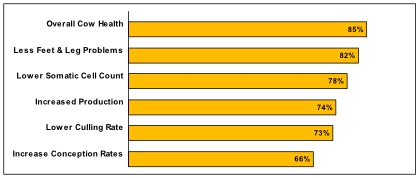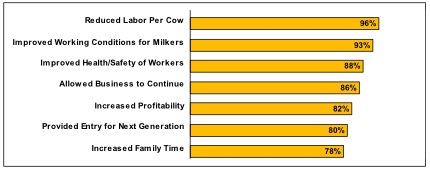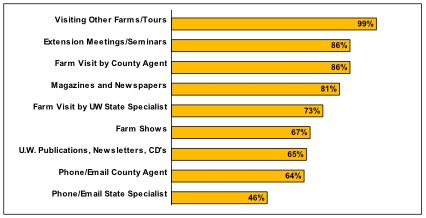 |
October 2010
|
October 2010 // Volume 48 // Number 5 // Research In Brief // v48-5rb7
Dairy Modernization Works for Family Farms
Abstract
Results are presented from a survey conducted in 2008 on small- to average-sized Wisconsin family dairy farms that had switched from milking cows in a stall barn to some type of parlor milking system. The survey was used to determine the producers' observations as to the major benefits to both themselves and the cows after modernizing their facilities. Producers were also asked to identify the educational resources they used, the most challenging aspect of the modernization process, grant and loan programs used, and impacts on labor.
Introduction and Background
Approximately 80% of the dairy herds in Wisconsin are made up of less than 100 cows (Wisconsin Statistical Publications, 2008). The majority of these herds are milked and housed in the traditional stall barns, many of which were built in the early 1900's with stall dimensions for cows that were much smaller in size and produced about one-fifth of the milk that today's cows produce. With worn out stalls that lack adequate space for cow comfort, many smaller dairy producers are faced with the decision to either make an investment to modernize their dairy facilities or exit the industry.
The options for small-sized dairy operations to continue in the business usually include remodeling the present barn and adding more stalls, building a freestall barn and parlor at a new location, or building a new freestall barn and some type of retrofit parlor inside their present stall barn. Most family dairies are seeking to reduce their labor requirements and also increase cow comfort. Dairy herds that modernize and expand require more non-family labor (Bewley, Palmer, & Jackson-Smith, 2001). However, many of them don't want to increase their herd size to the point of needing to rely heavily on off-farm labor.
Many smaller dairy farms have chosen to gradually modernize their facilities and to reduce milking center costs by constructing retrofit parlors. The modernization of facilities has enabled them to increase herd size without the need for additional labor and increase production per cow through greater cow comfort. In prior research in this area, farmers reported that the largest problem in expanding herd size was securing reliable non-family labor (Hadley, Harsh, & Wolf, 2002).
Survey Methodology
To get a measure on how modernization has worked on smaller sized dairy herds in Wisconsin, UW-Extension conducted a survey in 2008 on 104 dairies that had modernized their facilities within the past 10 years. UW-Extension County Agriculture agents assisted in collecting the data from 30 different counties. Survey data were edited for practical errors, and, after editing, 99 dairies were included in the final data set that is summarized in this article.
The survey data was compiled using Excel for mean and percentage calculations. The statistical analysis was completed by using the Statistical Package for Social Sciences (SPSS) software. The analysis for the significance of difference among the variables was calculated using a one-way analysis of variance (ANOVA). Significant differences were found in several labor categories and in the number cows milked per person between pre and post modernization.
The survey was conducted to determine what the producers observed as being the major benefits to modernizing from both the cow's and the producer's standpoint, to compare the pre- and post-modernization labor requirements, and to ascertain the types of educational resources that farmers used and valued the most during the modernization process.
Survey Results
The average herd size on the surveyed farms was 82 milk cows prior to doing a modernization and 203 cows after modernizing. This represents a 148% increase in herd size of the surveyed farms after modernization. However, the full time equivalents (F.T.E.) for dairy labor only increased by 84.6% after modernization. Gains in labor efficiency after modernizing their dairy facilities were also observed by the increase from 35 to 50 milk cows per F.T.E. General information for the surveyed farms for pre and post modernization is included in Table 1.
| General Farm Information | Pre Modernization | Post Modernization |
| Herd Size (Milk Cows) | 82 | 203 |
| Average Milk Production /Cow | 20,245 lbs. | 21,684 lbs. |
| Acres of Land Owned | 351 | 421 |
| Acres of Land Rented | 187 | 308 |
| Acres/Cow (owned & rented) | 6.56 | 3.59 |
| Labor F.T.E's for the Dairy | 2.34 | 4.32 |
| Milk Cows per F.T.E. | 35 | 50 |
Many dairy producers chose to rent additional land when expanding their herds and modernizing. The number of acres owned and rented per cow was reduced by 45.3% after modernization. This is not surprising given the high cost of land and limited capital available while undertaking a modernization project. The reduction in land base per cow after modernization was mainly offset by renting more acres vs. purchasing more land.
Milking Systems
Ninety-two of the farms reported that they had built a parlor, and the other seven farms were still milking in a stall barn. Sixty-two percent of the farms built retrofit parlors into existing facilities, and 38% constructed their parlor in a new building. The average time period for the farms to convert from their stall barn system to a parlor system was 17 weeks. This period was defined as the time from the start of parlor construction to the first milking in the new parlor.
The lowest cost parlors were flat parlors built inside existing facilities, with a cost of $3,360 per stall. Parallel parlors built into new construction were the most expensive, at a cost of $22,361 per stall. The lower cost for retrofit parlors results from lower building and milk equipment costs. Farmers also provided more of their own labor (44.8%) in building the retrofit parlors than those who built with new construction (23.8%). The average per stall costs of all the parlors is shown in Table 2. The rotary parlors in the study were not included in the stall cost comparison below.
| Parlor Stall Type | Retrofit Construction (n=55) | New Construction (n= 34) |
| Flat barn | $3,360 (n=6) | NA |
| Herringbone | $9,657 (n=8) | $18,769 (n=4) |
| Parabone | $3,845 (n=30) | $6,016 (n= 11) |
| Parallel | $7,478 (n=11) | $22,361 (n=19) |
Labor Impacts
Producers reported the amount of time they spent daily for milking, milking setup and cleanup, feeding milk cows, stall maintenance, handling cows, and handling manure. This was done for both pre and post modernization so that a comparison could be made. Dairy producers were able to milk almost 2.5 times more cows without adding much additional labor after modernizing their dairy facilities. The labor savings on a per cow basis were statistically significant for all of the daily chores reported and are summarized in Table 3.
| Chore | n | Pre Modernization Mean | Post Modernization Mean | Time Change Cow/Day | Pooled Standard Deviation |
| Milking Setup/Clean | 90 | .51 | .32 | *.19 | .39 |
| Milking | 90 | 4.07 | 2.09 | ** 1.98 | 1.56 |
| Feeding Milk Cows | 94 | 1.59 | .65 | ** .94 | .70 |
| Handling Cows | 89 | .75 | .49 | * .26 | .56 |
| Maintaining Stalls | 89 | .80 | .32 | ** .48 | .38 |
| Handling Manure | 83 | .79 | .40 | ** .39 | .46 |
| **P=<.001 *P=<.01 Total Time Savings: 4.24 minutes/cow/day | |||||
The reduction in labor per cow for feeding and handling cows, milking setup/cleanup, milking, maintaining stalls, and handling manure totaled 25.80 hours per cow per year on the surveyed farms. The annual per cow hourly labor savings are listed in Table 4 along with the economic impact of the labor savings based on labor at $12 /hour for each farm.
The 92 dairies that switched from a stall barn to some type of parlor milking system reported milking an average of 22.7 cows/hour/person prior to modernization. After modernizing with a parlor milking system, these farms reported milking an average of 44.1 cows/hour/person. The range of cows milked/person/hour after modernization ranged from a low of 21.1 cows in a double 12 parallel parlor, to a high of 108 cows milked/person/hour in a double 16 parallel parlor. These numbers illustrate that the efficiency of the parlor operators has more to do with cow throughput per hour than does the type of parlor used.
| Work Task | Reduced Time Per Cow/Day | Reduced Hours Per Cow/Year | Labor Rate | Dollar Savings of Labor Reduction |
| Milking Setup/Cleanup | .19 | 1.16 | $12 | $13.92 |
| Milking | 1.98 | 12.05 | $12 | $144.60 |
| Feeding Milk Cows | .94 | 5.72 | $12 | $68.64 |
| Handling Cows | .26 | 1.58 | $12 | $18.96 |
| Maintaining Stalls | .48 | 2.92 | $12 | $35.04 |
| Handling Manure | .39 | 2.37 | $12 | $28.44 |
| Totals: | 4.24 min./day | 25.80 Hours | $309.60/Cow/Yr |
Cow Benefits from Modernization
Producers were asked to identify the cow benefits that they observed as a result of their modernization projects. The highest reported benefit for the cow from modernizing was the improvement of overall cow health, which was observed on 85% of the farms. The complete results of the cow benefits observed by producers are shown in Figure 1.
Figure 1.
Percentage of Producers
Reporting Cow Benefits

People Benefits Observed from Modernization
The reduction in labor per cow was the number one personal benefit reported by producers from modernizing their facilities, with 96% of the producers reporting it on the survey. Improved working conditions and safety for workers were listed as the next highest benefits. These were followed in order by allowing the business to continue, increased profitability, providing entry for the next generation, and increased family time. Prior research on larger dairy farms reported increased profitability as the number one reason they modernized (Hadley et al., 2002). The percentage of farms reporting the observed benefits to people is shown in Figure 2.
Figure 2.
People Benefits Observed by
Producers After Modernization

Educational Resources Used
The survey asked producers to identify the educational resources they used in designing their dairy modernization projects. The most popular educational resource used by producers was touring and visiting other farms, with 99% stating that they had done so. Eighty-six percent of the producers reported using farm visits and seminars conducted by UW-Extension. The other educational resources used by producers are shown in Figure 3.
Figure 3.
Percentage of Producers
Reporting the Use of Educational Resources

Dairy producers were asked to rank the educational resources they found most useful on a scale of 1 to 6, with one being the least helpful and 6 being the most helpful. They ranked visiting other farms the highest, with a score of 5.48. This confirms that even though freestall buildings and parlors are not a new concept, they are still new to those who do not have them, and farmers highly value organized tours to other farms that have modernized. Producers ranked farm visits by UW-Extension state specialists and county agriculture agents as also being very helpful, with scores of 4.60 and 4.52 out of 6 respectively. These concur with previous research findings done in Vermont by Calderwood (1997) and in Virginia by Obahayujie and Hilson (1988). The producer rankings for the educational resources they used are shown in Figure 4.
Figure 4.
Producer Rankings for Usefulness
of Educational Resources

Ninety-three percent of the dairy farmers reported receiving assistance from UW-Extension agents and specialists in planning their modernization projects. Eighty-nine percent reported receiving assistance from their milk equipment dealer, 86% from other dairy producers, 85% from their builder/contractor, and 76% from their agriculture lender. Seventy-eight percent of the producers also indicated that assistance from Extension had affected their decisions to modernize. The top five areas on how UW-Extension assisted them are listed in Table 5.
| Number of Reponses | Producer Responses |
| 26 | Assisted in parlor location and design |
| 20 | Organized tours & farm visits to observe modernization projects on farms |
| 15 | Presented new ideas and options for parlor design and construction |
| 12 | Design and layout of cow housing including cow flow and stall size |
| 9 | UW-Extension sponsored educational meetings and tours started the process |
When asked what their biggest challenge was during the modernization process, the top answer was working with contractors and/or serving as the general contractor on the project. The other major challenges reported were deciding what system and the number of cows that would work the best on their farm, budgeting and financing, facility design, cost overruns, and finding good and knowledgeable contractors.
Producers were asked to identify one thing about their modernization project that they would change. The number one response was that they would have done the modernization sooner. The second most popular response was that they would have made either the parlor or the freestall barns bigger, and the third highest reported comment was that they would have started at an alternate site to allow for more future expansion. Forty-three percent of the surveyed producers also indicated that they would no longer be in the dairy business had they not modernized their facilities.
Economic Impacts
The 99 farms surveyed reported a total economic investment of over $65.3 million (2008 dollars) into modernizing their dairy facilities. That is an average investment of $659,596 per farm and $3,250 per cow. The investments in modernizing milking parlors and milk cow housing represented 73% of the total amount spent.
The average annual milk production per cow increased by 1,439 pounds, and the average herd size increased by 121 cows after the modernization projects were completed. These two factors combined for a total increase of 266,535,141 pounds of milk sold for all the farms in the study as shown in Table 6.
| Pre Modernization | Post Modernization | Total Increase for All Farms | |
| Milk Cows | 7,923 | 19,689 | +11,766 |
| Ave. Herd Size | 82 | 203 | +121 |
| Total Annual Milk Production (lbs) | 160,401,135 | 426,936,276 | +266,535,141 |
| Ave. Production per Cow (lbs) | 20,245 | 21,684 | +1,439 |
Using a farm milk price of $15/cwt, with premiums included, the increased production per cow of 1,439 pounds would have a value of $216 in increased milk income per cow per year. When the average reported increase of 121 cows per farm is added to the increased milk production per cow, it results in the average gross milk sales increasing by a total of $411,177 for each farm in the study. The increase in overall cow health that was reported by farmers would also likely reduce vet and medical costs; however, this cost information was not collected in the survey.
Conclusions
The survey reported here illustrates that Extension can play a large role in helping smaller family dairies remain in business by increasing milk production per cow and reducing labor through modernizing their dairy facilities. Farmers used and valued the information they received from UW-Extension specialists and county agents in exploring lower cost options for modernizing their dairy operations.
The surveyed family dairy farms ranked overall cow health and the reduction of labor per cow as the most important benefits they observed from the modernization of their facilities. These factors have helped many Wisconsin dairy farmers to continue in the dairy business, while also making dairying more attractive to younger producers looking to enter the industry.
References
Bewley, J., Palmer, R. W., & Jackson-Smith, D.B. (2001) An overview of experiences of Wisconsin dairy farmers who modernized their operation. Journal of Dairy Science, 84: 717-729.
Calderwood, L. (1997). Survey of value and importance of farm visits to Eastern Vermont dairy farmers. Journal of Extension [On-Line], 35(2) Article 2RIB2. Available at: http://www.joe.org/joe/1997april/rb2.php
Hadley, G. L., Harsh, S. B., & Wolf, C. A. (2002). Managerial and financial implications of major dairy farm expansions in Michigan and Wisconsin. Journal of Dairy Science. 85: 2053-2064.
Obahayujie, J., & Hilson, J. (1988). Now hear this! Journal of Extension [On-Line], 26(1) Article 1FEA6. Available at: http://www.joe.org/joe/1988spring/a6.php
Wisconsin Dairy Statistical Publications. United States Department of Agriculture, National Agricultural Statistics Service, 2008. Retrieved December 3, 2008 from: http://www.nass.usda.gov/Statistics_by_State/Wisconsin/Publications/Dairy/index.asp




